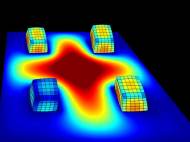Synthetic material rebuilds itself through chemical communication
 University of Pittsburgh (Pitt) researchers have found that self-moving gels can be used to enable the synthetic materials to “act alive” and mimic primitive biological communication. They managed to demonstrate that a synthetic system that can both emit and sense a chemical signal, and when the ability of chemical communication is combined with interaction with light, the material can drive neighboring gel pieces to spontaneously self-aggregate or move in desired patterns.
University of Pittsburgh (Pitt) researchers have found that self-moving gels can be used to enable the synthetic materials to “act alive” and mimic primitive biological communication. They managed to demonstrate that a synthetic system that can both emit and sense a chemical signal, and when the ability of chemical communication is combined with interaction with light, the material can drive neighboring gel pieces to spontaneously self-aggregate or move in desired patterns.
The results were achieved on Belousov-Zhabotinsky (BZ) gel – a material first fabricated in the late 1990s which exhibits the ability to pulsate in the absence of any external stimuli. In a previous study, a team of researchers from Pitt noticed that long pieces of BZ gel attached to a surface by one end “reached” toward one another, almost as if they were trying to communicate by sending signals.
This phenomenon inspired Anna Balazs, principal investigator of the study and Distinguished Professor of Chemical and Petroleum Engineering in Pitt’s Swanson School of Engineering, and her research team to detach the fixed ends of the gels and allow them to move freely. They developed a 3D gel model to test the effects of the chemical signaling and light on the material.
“This study demonstrates the ability of a synthetic material to actually ‘talk to itself’ and follow out a given action or command, similar to such biological species as amoeba and termites”, said Balazs. “Imagine a LEGO set that could by itself unsnap its parts and then put itself back together again in different shapes but also allow you to control those shapes through chemical reaction and light.”
The results showed that when the gel pieces were moved far apart from each other, they were able to automatically come back together. The ability of autochemotaxis enables the material to be divided into separated parts and the parts move autonomously to assemble into a structure which resembles the original.
“We find this system to be extremely exciting and important because it provides a unique opportunity to study autochemotaxis in synthetic systems”, said Olga Kuksenok, a member of the research team and research associate professor in the Swanson School’s Department of Chemical Engineering.
Pitt researchers reported that they were able to use the light to coordinate the gel’s motion, thus allowing selective self-aggregation and control over the shape of the gel aggregates. They also managed to create an equivalent of a train, where researchers applied specific patterns of light and dark onto BZ gels to create a BZ gel “train” that leads the movement of its “cargo”.
Aside paving the way for creating reconfigurable materials from self-propelled elements, which autonomously communicate with neighboring units and thereby actively participate in constructing the final structure, these finding could be used in creation of next generation of self-healing materials.
For more information, you can read the paper published in the Proceedings of the National Academy of Sciences: “Reconfigurable assemblies of active, autochemotactic gels” [808KB PDF].









Leave your response!